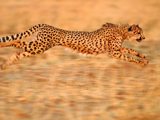Be the Cheetah
What is success and how do you define it?
At times success can be difficult to recognize and how you define success has a major impact on the decisions you make.
In abundant times, times of success, we are less likely to consider or invest in changes or improving efficiencies. This is because often the investment does not provide an immediate financial return and, like so many animals, we only hunt when we are hungry.
Times have changed, and clients have become more agile and are hungry for greater efficiencies. At the same time, the competition has become more intense. This combination means we must have a solid understanding of our objectives, strong strategies, and appropriate tactics for achieving them. Finally, we need to have the means to measure our success.
Using a hunting analogy, if you see a cheetah consuming a hare it caught, you would assume the cheetah was successful. However, if the cheetah spent more energy chasing the hare across the Serengeti than the meal replenished, we could agree that by repeating this behavior, whether days or weeks, the cheetah will eventually starve.
If we spend more resources than we gain, we will ultimately fail, whether in business or the animal kingdom. In the case of businesses, the timeline is longer, perhaps months or years. So, how do we ensure we are not eating, but still starving?
The answer is to be the cheetah. The cheetah’s success and survival begin with a good strategy. Cheetahs are selective about when and where they expend their energy. This starts with an analysis of the environment and potential prey. From here, cheetahs make a judgment regarding the potential for success.
The tactics employed to support and follow their pre-hunt strategy. Once the hunt begins, the cheetah constantly evaluates and analyzes the situation in terms of the maneuvers required and the amount of energy expended to catch its prey. Often after only a short pursuit the cheetah will break off the chase and return to the shade having determined more energy (resources) would be spent than gained. It literally isn’t worth the effort.
In the past, companies may have been able to survive and even flourish with “from the hip decisions” or following strategies and tactics that had been successful previously. Times have changed and the prey is leaner. In response, our strategies and tactics must adapt, and become smarter we need to hunt with the efficiencies of the cheetah. This requires we implement evidence-based decision-making.
The process of evidence-based decision-making is cyclical and can be divided into five main stages.
1) Analyze Information: Apply market knowledge and modern tools to analyze real-world data in order to uncover actional insights
2) Develop your Strategy: Good strategy is based on empirical evidence and business acumen. Rarely do we have perfect information and rarely are we forced to make a decision without any information. Thus, strategy is as much art as it is science.
3) Design Tactics: Your tactics must reflect the target and strategy. Multiple targets require multiple strategies. Just as the cats of the Serengeti employ different tactics depending on their prey so must you.
4) Execute your Strategies and Tactics: Action is everything! The best strategies and tactics are useful only if they can be implemented. Have you developed relevant and achievable methods to achieve your goal? Are these strategies and tactics adequately supported? Or are you a rogue cheetah in search of an elephant?
5) Measure the Response; Calculate your Return-On-Investment: “If it can’t be measured you probably should not be doing it.” Without a good understanding of the return-on-investment, you run the risk of starving. This may be the last stage but it must be considered first. Future analysis will be based on the measurement of current programs.
Another factor in the process includes your ‘hypotheses. Your experience and intelligence will guide your mission and set you apart as a true leader. Remember good leaders transform bad businesses to become successful ones. Bad leaders can make a good business fail.
Today, many companies are facing the equivalent of a drought (or dry season) in the African plains. During these times the weak will perish, and the strong will survive. A structured approach to evidence-based decision-making strengthens companies to help ensure their survival.

MedFuse
Pennsylvania Biotechnology Center
3805 Old Easton Road
Doylestown, PA 18902
Tel. (833) 844-3282


